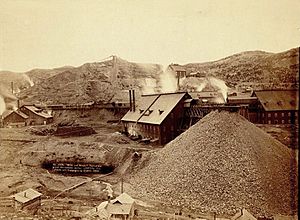Black Hills Gold Rush facts for kids
The Black Hills Gold Rush was a period in the United States when many people rushed to the Black Hills area of Dakota Territory to find gold. It started in 1874 after an expedition led by George Armstrong Custer. The rush was most active in 1876 and 1877.
People had heard rumors about gold in the Black Hills since the early 1800s. In the 1860s, a missionary named Father De Smet reportedly saw Sioux Native Americans with gold they said came from the Black Hills.
Before the Gold Rush, the Black Hills were home to Native American tribes, mainly the Sioux. The U.S. government had agreed that the Black Hills belonged to the Sioux in the Treaty of Laramie in 1868. This meant the area was off-limits to white settlers. However, many white Americans were very interested in finding gold there.
In 1874, gold was found near what is now Custer, South Dakota. But this discovery was small. Much larger gold deposits were found in November 1875 in an area called Deadwood Gulch. By 1876, thousands of gold-seekers traveled to the new town of Deadwood. This was still on Native American land.
Contents
History of the Gold Rush

The Black Hills Gold Rush officially began in 1874. The first group to arrive was about 1,000 men led by George Armstrong Custer. Their job was to check if there was gold in the area. This was despite the land belonging to the Sioux people.
Where Was Gold First Found?
Custer's group found small amounts of gold near what is now Custer, South Dakota. They then looked for places with more gold. They moved north and helped start towns like Hill City, Sheridan, and Pactola. In each of these spots, they found small flakes of gold. But it wasn't the huge amount they hoped for.
Things changed when miners found gold along Deadwood and Whitewood Creeks in the northern Black Hills. For the first people who discovered it, every shovel full of dirt seemed to hold a lot of gold.
The Rush to Deadwood
By 1876, miners had claimed all the land around these creeks. Even though all the good spots were taken, thousands more people still came. They hoped to find a spot that someone else had missed. The gold found here was called placer gold. This meant it was loose pieces of gold mixed with rocks and soil in stream beds.
Most experienced gold seekers knew that placer gold came from larger, harder rock deposits. So, while many people went to Deadwood, others looked for the source of the placer gold.
Discovery of the Homestake Mine
On April 9, 1876, Fred and Moses Manuel, Hank Harney, and Alex Engh found a gold deposit near Lead, South Dakota. They claimed their discovery and named it the Homestake. They had found the main source of the placer gold in Deadwood Creek. Over the next 125 years, this mine produced about 10% of the world's gold supply. Many other gold seekers hoped to find another "Homestake," but this mine was truly special.
How Was Gold Extracted?
At the Homestake Mine, workers crushed the gold-bearing rock. Then, they used gravity to separate the gold. After that, they mixed the gold with mercury. The mercury would combine with the gold. Miners called this process "free milling."
Gold was found in other parts of the Black Hills too. However, it was often "refractory gold ore." This meant the gold was chemically stuck to the rock and very hard to remove. For many years, Homestake was the only major gold mine in the Black Hills. Later, in the 1890s, new methods like chlorination and smelting helped remove gold from refractory ore. This led to more mining areas opening up around Lead and Deadwood.
Robberies of Gold Shipments
During the gold rush, "Treasure Coaches" carried large amounts of gold. These coaches often transported gold worth up to $300,000 in one trip to Cheyenne, Wyoming. This made them a popular target for bandits.
The last recorded robbery happened on September 26, 1878. It was at the Canyon Springs station, about 35 miles south of Deadwood. The robbers attacked the coach, and one guard was killed, while two others were hurt. The chief guard managed to make a deal with the bandits to leave the coach. After he left, the outlaws broke open the safe, took the gold, and rode away. People in the area organized groups to find the robbers. The stagecoach company also offered a $2,500 reward. Many suspects were caught, and more than half of the gold was eventually found.
In Popular Culture
The Black Hills Gold Rush is the setting for the HBO TV show called Deadwood.

